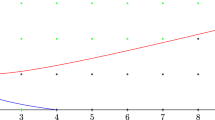Abstract
The theory of error-correcting codes is concerned with constructing codes that optimize simultaneously transmission rate and relative minimum distance. These conflicting requirements determine an asymptotic bound, which is a continuous curve in the space of parameters. The main goal of this paper is to relate the asymptotic bound to phase diagrams of quantum statistical mechanical systems. We first identify the code parameters with Hausdorff and von Neumann dimensions, by considering fractals consisting of infinite sequences of code words. We then construct operator algebras associated to individual codes. These are Toeplitz algebras with a time evolution for which the KMS state at critical temperature gives the Hausdorff measure on the corresponding fractal. We extend this construction to algebras associated to limit points of codes, with non-uniform multi-fractal measures, and to tensor products over varying parameters.
Similar content being viewed by others
References
Accardi L., Imafuku K.: Dynamical detailed balance and local KMS condition for non-equilibrium states. Int. J. Mod. Phys. B 18(4–5), 345–467 (2004)
Bost J.B., Connes A.: Hecke algebras, Type III factors and phase transitions with spontaneous symmetry breaking in number theory. Sel. Math. (New Ser.) 1(3), 411–457 (1995)
Connes A.: A survey of foliations and operator algebras. Proc. Sympos. Pure Math. 38(Part I), 85–115 (1982)
Connes A.: Une classication des facteurs de type III. Ann. Sci. École Norm. Sup. 6(4), 133–252 (1973)
Cuntz J.: Simple C*-algebras generated by isometries. Commun. Math. Phys. 57, 173–185 (1977)
Dutkay D.E., Jorgensen P.E.T.: Iterated function systems, Ruelle operators, and invariant projective measures. Math. Comp. 75, 1931–1970 (2006)
Eilenberg S.: Automata, Languages, and Machines, vol. Academic Press, London (1974)
Exel R.: A new look at the crossed-product of a C*-algebra by an endomorphism. Ergod. Theory Dyn. Syst. 23, 1733–1750 (2003)
Falconer K.: Fractal Geometry. Wiley, New York (1990)
Fowler N.J.: States of Toeplitz–Cuntz algebras. J. Oper. Theory 42(1), 121–144 (1999) arxiv:funct-an/9702012
Ingarden R.S., Kossakowski A., Ohya M.: Information Dynamics and Open Systems. Kluwer, Dordrecht (1997)
Kishimoto A., Kumjian A.: Simple stably projectionless C*-algebras arising as crossed products. Can. J. Math. 48, 980–996 (1996)
Kumjian A., Renault J.: KMS states on C*-algebras associated to expansive maps. Proc. AMS 134, 2067–2078 (2006)
Li M., Vitányi P.M.B.: An Introduction to Kolmogorov Complexity and its Applications. Springer, New York (1997)
Manin Y.I.: What is the maximum number of points on a curve over F 2?. J. Fac. Sci. Tokyo, IA 28, 715–720 (1981)
Manin Y.I., Vladut S.G.: Linear codes and modular curves. J. Soviet Math. 30, 2611–2643 (1985)
Marcolli, M., Paolucci, A.M.: Cuntz–Krieger algebras and wavelets on fractals. arXiv:0908.0596
Ryabko B.Y.: Noiseless coding of combinatorial sources. Probl. Inf. Transm. 22, 170–179 (1986)
Ryabko B.Y.: Coding of combinatorial sources and Hausdorff dimension. Soviet Math. Doklady 30(1), 219–222 (1984)
Staiger L.: Kolmogorov complexity and Hausdorff dimension. Inf. Comput. 103, 159–194 (1993)
Tsfasman M.A., Vladut S.G.: Algebraic-Geometric Codes. Kluwer, Dordrecht (1991)
Uspensky V.A., Shen A.: Relations between varieties of Kolmogorov complexity. Math. Syst. Theory 29, 271–292 (1996)
Zvonkin A.K., Levin L.A.: The complexity of finite objects and the basing of the concepts of information and randomness on the theory of algorithms. Russ. Math. Surv. 25(6), 83–124 (1970)
Author information
Authors and Affiliations
Corresponding author
Rights and permissions
About this article
Cite this article
Manin, Y.I., Marcolli, M. Error-Correcting Codes and Phase Transitions. Math.Comput.Sci. 5, 133–170 (2011). https://doi.org/10.1007/s11786-010-0031-8
Received:
Accepted:
Published:
Issue Date:
DOI: https://doi.org/10.1007/s11786-010-0031-8



